technical data SKODA FABIA 2006 2.G / 5J Owner's Guide
[x] Cancel search | Manufacturer: SKODA, Model Year: 2006, Model line: FABIA, Model: SKODA FABIA 2006 2.G / 5JPages: 258, PDF Size: 44.86 MB
Page 44 of 258
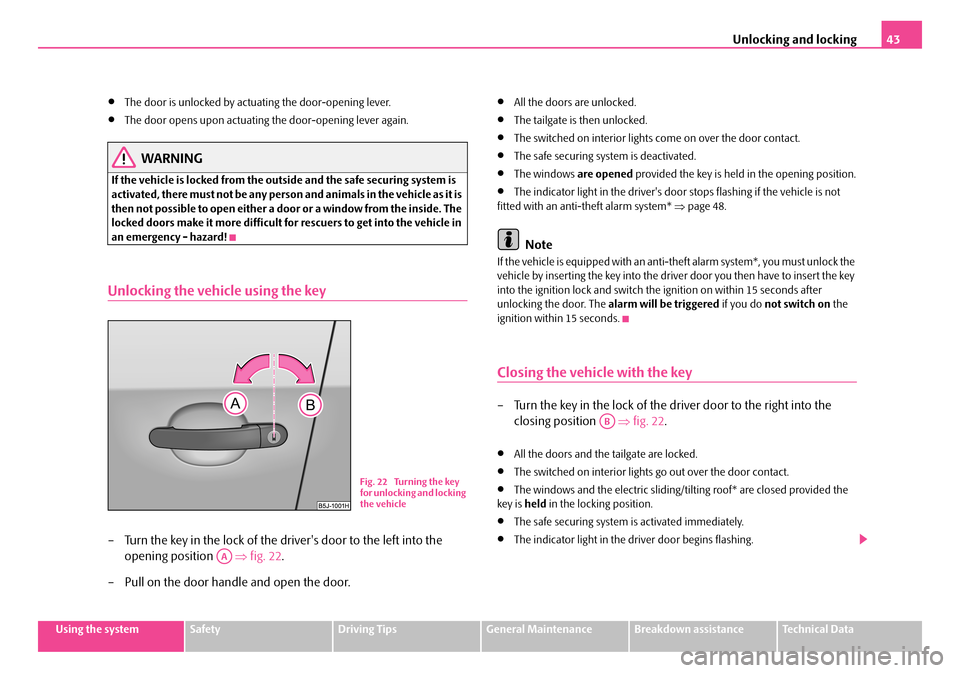
Unlocking and locking43
Using the systemSafetyDriving TipsGeneral MaintenanceBreakdown assistanceTechnical Data
•The door is unlocked by actuating the door-opening lever.
•The door opens upon actuating the door-opening lever again.
WARNING
If the vehicle is locked from the outside and the safe securing system is activated, there must not be any person and animals in the vehicle as it is then not possible to open either a door or a window from the inside. The locked doors make it more difficult for rescuers to get into the vehicle in an emergency - hazard!
Unlocking the vehicle using the key
– Turn the key in the lock of the dr iver's door to the left into the
opening position ⇒fig. 22.
– Pull on the door handle and open the door.
•All the doors are unlocked.
•The tailgate is then unlocked.
•The switched on interior lights come on over the door contact.
•The safe securing system is deactivated.
•The windows are opened provided the key is held in the opening position.
•The indicator light in the driver's door stops flashing if the vehicle is not fitted with an anti-theft alarm system* ⇒page 48.
Note
If the vehicle is equipped with an anti-theft alarm system*, you must unlock the vehicle by inserting the key into the driver door you then have to insert the key into the ignition lock and switch th e ignition on within 15 seconds after unlocking the door. The alarm will be triggered if you do not switch on the ignition within 15 seconds.
Closing the vehicle with the key
– Turn the key in the lock of the dr iver door to the right into the
closing position ⇒fig. 22.
•All the doors and the tailgate are locked.
•The switched on interior lights go out over the door contact.
•The windows and the electric sliding/tilting roof* are closed provided the key is held in the locking position.
•The safe securing system is activated immediately.
•The indicator light in the driver door begins flashing.
Fig. 22 Turning the key for unlocking and locking the vehicle
AA
AB
NKO A05Fabia 20.book Page 43 Tuesday, September 26, 2006 8:38 AM
Page 46 of 258
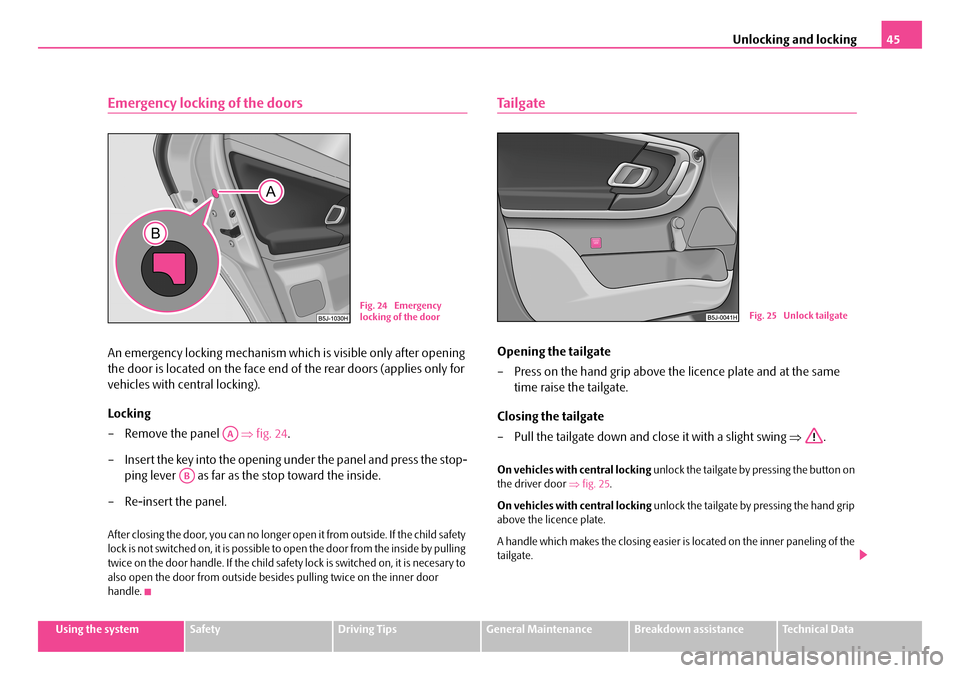
Unlocking and locking45
Using the systemSafetyDriving TipsGeneral MaintenanceBreakdown assistanceTechnical Data
Emergency locking of the doors
An emergency locking mechanism which is visible only after opening
the door is located on the face end of the rear doors (applies only for
vehicles with central locking).
Locking
– Remove the panel ⇒fig. 24.
– Insert the key into the opening under the panel and press the stop-
ping lever as far as the stop toward the inside.
–Re-insert the panel.
After closing the door, you can no longer op en it from outside. If the child safety lock i s not swi tche d on, it i s poss ible to open the d oor f rom the ins ide by pulli ng twice on the door handle. If the child safety lock is switched on, it is necesary to also open the door from outside besi des pulling twice on the inner door handle.
Ta i l g a t e
Opening the tailgate
– Press on the hand grip above th e licence plate and at the same
time raise the tailgate.
Closing the tailgate
– Pull the tailgate down and close it with a slight swing ⇒.
On vehicles with central locking unlock the tailgate by pressing the button on the driver door ⇒fig. 25.
On vehicles with central locking unlock the tailgate by pressing the hand grip above the licence plate.
A handle which makes the closing easier is located on the inner paneling of the tailgate.
Fig. 24 Emergency locking of the door
AA
AB
Fig. 25 Unlock tailgate
NKO A05Fabia 20.book Page 45 Tuesday, September 26, 2006 8:38 AM
Page 48 of 258
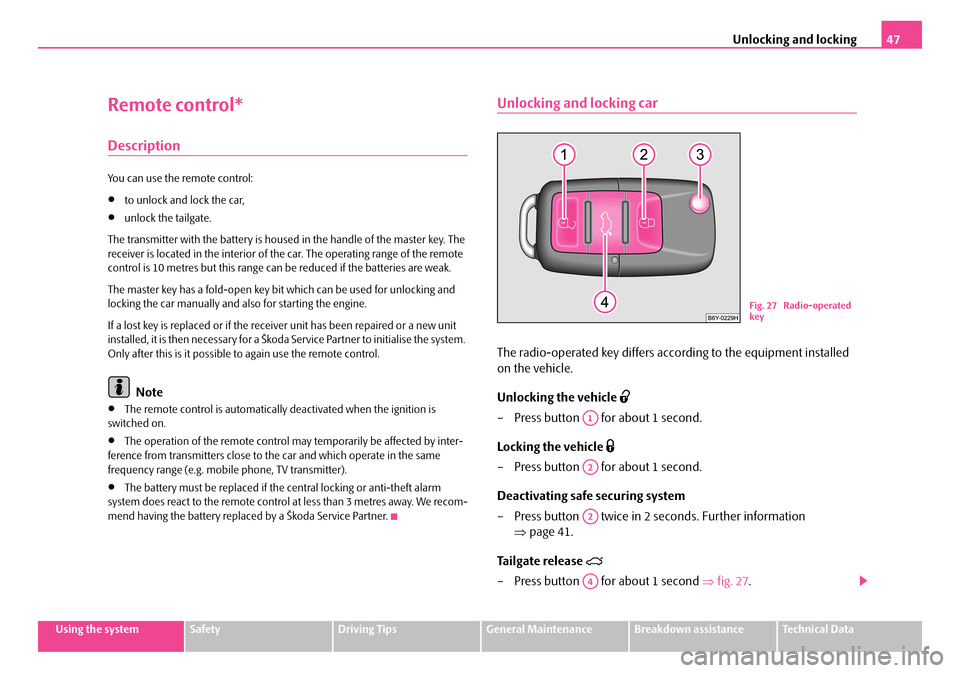
Unlocking and locking47
Using the systemSafetyDriving TipsGeneral MaintenanceBreakdown assistanceTechnical Data
Remote control*
Description
You can use the remote control:
•to unlock and lock the car,
•unlock the tailgate.
The transmitter with the battery is housed in the handle of the master key. The receiver is located in the interior of th e car. The operating range of the remote control is 10 metres but this range can be reduced if the batteries are weak.
The master key has a fold-open key bit which can be used for unlocking and locking the car manually and al so for starting the engine.
If a lost key is replaced or if the rece iver unit has been repaired or a new unit installed, it is then necessary for a Škoda Service Partner to initialise the system. Only after this is it possible to again use the remote control.
Note
•The remote control is automatically deactivated when the ignition is switched on.
•The operation of the remote control may temporarily be affected by inter- ference from transmitters close to th e car and which operate in the same frequency range (e.g. mobile phone, TV transmitter).
•The battery must be replaced if the central locking or anti-theft alarm system does react to the remote control at less than 3 metres away. We recom- mend having the battery replaced by a Škoda Service Partner.
Unlocking and locking car
The radio-operated key differs according to the equipment installed
on the vehicle.
Unlocking the vehicle
– Press button for about 1 second.
Locking the vehicle
– Press button for about 1 second.
Deactivating safe securing system
– Press button twice in 2 seconds. Further information
⇒ page 41.
Tailgate release
– Press button for about 1 second ⇒fig. 27.
Fig. 27 Radio-operated key
A1
A2
A2
A4
NKO A05Fabia 20.book Page 47 Tuesday, September 26, 2006 8:38 AM
Page 50 of 258
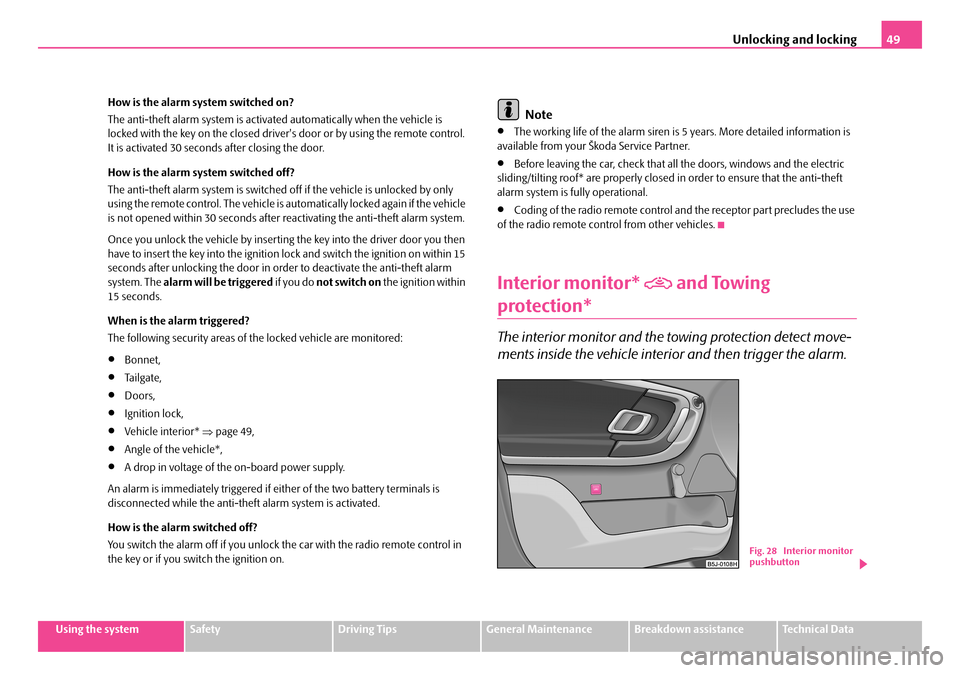
Unlocking and locking49
Using the systemSafetyDriving TipsGeneral MaintenanceBreakdown assistanceTechnical Data
How is the alarm system switched on?
The anti-theft alarm system is activated automatically when the vehicle is locked with the key on the closed driver's door or by using the remote control. It is activated 30 seconds after closing the door.
How is the alarm sy stem switched off?
The anti-theft alarm system is switched off if the vehicle is unlocked by only using the remote control. The vehicle is automatically locked again if the vehicle is not opened within 30 seconds after reactivating the anti-theft alarm system.
Once you unlock the vehicle by inserting the key into the driver door you then have to insert the key into the ignition lock and switch the ignition on within 15 seconds after unlocking the door in order to deactivate the anti-theft alarm system. The alarm will be triggered if you do not switch on the ignition within 15 seconds.
When is the alarm triggered?
The following security areas of the locked vehicle are monitored:
•Bonnet,
•Tailgate,
•Doors,
•Ignition lock,
•Vehicle interior* ⇒page 49,
•Angle of the vehicle*,
•A drop in voltage of the on-board power supply.
An alarm is immediately triggered if either of the two battery terminals is disconnected while the anti-theft alarm system is activated.
How is the alarm switched off?
You switch the alarm off if you unlock th e car with the radio remote control in the key or if you switch the ignition on.
Note
•The working life of the alarm siren is 5 years. More detailed information is available from your Škoda Service Partner.
•Before leaving the car, check that all the doors, windows and the electric sliding/tilting roof* are properly closed in order to ensure that the anti-theft alarm system is fully operational.
•Coding of the radio remote control and the receptor part precludes the use of the radio remote control from other vehicles.
Interior monitor* and Towing
protection*
The interior monitor and the to wing protection detect move-
ments inside the vehicle interi or and then trigger the alarm.
Fig. 28 Interior monitor pushbutton
NKO A05Fabia 20.book Page 49 Tuesday, September 26, 2006 8:38 AM
Page 52 of 258
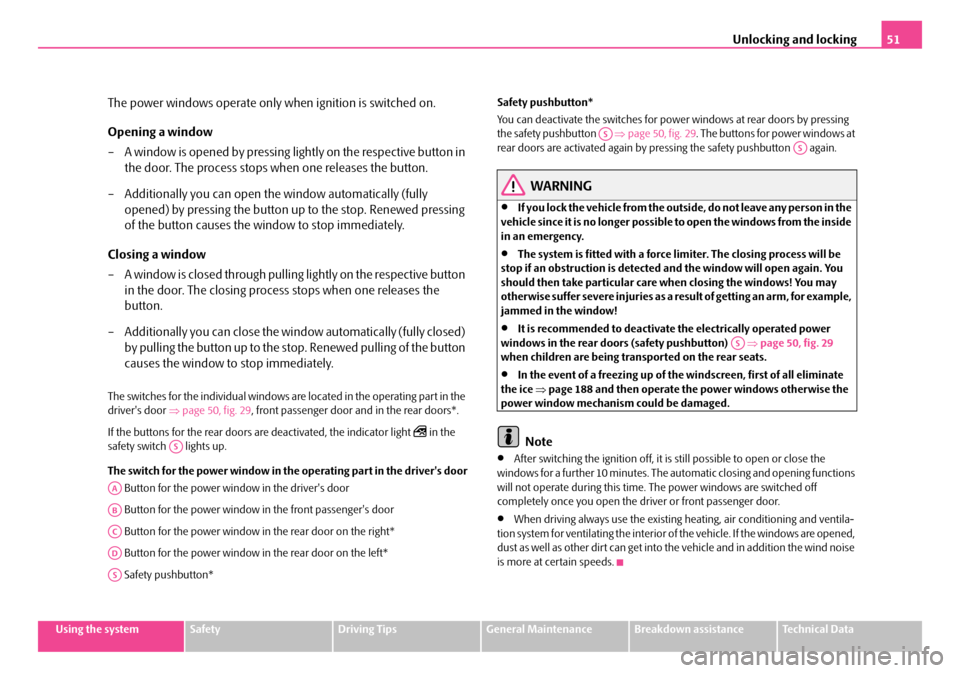
Unlocking and locking51
Using the systemSafetyDriving TipsGeneral MaintenanceBreakdown assistanceTechnical Data
The power windows operate only when ignition is switched on.
Opening a window
– A window is opened by pressing lightly on the respective button in
the door. The process stops when one releases the button.
– Additionally you can open the window automatically (fully
opened) by pressing the button up to the stop. Renewed pressing
of the button causes the window to stop immediately.
Closing a window
– A window is closed through pullin g lightly on the respective button
in the door. The closing process stops when one releases the
button.
– Additionally you can close the window automatically (fully closed)
by pulling the button up to the stop. Renewed pulling of the button
causes the window to stop immediately.
The switches for the individual windows are located in the operating part in the driver's door ⇒page 50, fig. 29, front passenger door and in the rear doors*.
If the buttons for the rear doors ar e deactivated, the indicator light in the safety switch lights up.
The switch for the power window in th e operating part in the driver's door
Button for the power window in the driver's door
Button for the power window in the front passenger's door
Button for the power window in the rear door on the right*
Button for the power window in the rear door on the left*
Safety pushbutton*
Safety pushbutton*
You can deactivate the switches for powe r windows at rear doors by pressing the safety pushbutton ⇒page 50, fig. 29. The buttons for power windows at rear doors are activated again by pre ssing the safety pushbutton again.
WARNING
•If you lock the vehicle from the outside, do not leave any person in the vehicle since it is no longer possible to open the windows from the inside in an emergency.
•The system is fitted wi th a force limiter. The closing process will be stop if an obstruction is detected and the window will open again. You should then take particular care when closing the windows! You may otherwise suffer severe injuries as a re sult of getting an arm, for example, jammed in the window!
•It is recommended to deactivate the electrically operated power windows in the rear doors (safety pushbutton) ⇒page 50, fig. 29 when children are being transported on the rear seats.
•In the event of a freezing up of th e windscreen, first of all eliminate the ice ⇒page 188 and then operate the power windows otherwise the power window mechanism could be damaged.
Note
•After switching the ignition off, it is still possible to open or close the windows for a further 10 minutes. The automatic closing and opening functions will not operate during this time. The power windows are switched off completely once you open the driver or front passenger door.
•When driving always use the existing heating, air conditioning and ventila- tion system for ventilating the interior of the vehicle. If the windows are opened, dust as well as other dirt can get into the vehicle and in addition the wind noise is more at certain speeds.
AS
AA
AB
AC
AD
AS
ASAS
AS
NKO A05Fabia 20.book Page 51 Tuesday, September 26, 2006 8:38 AM
Page 54 of 258

Unlocking and locking53
Using the systemSafetyDriving TipsGeneral MaintenanceBreakdown assistanceTechnical Data
Proceed as follows to close the window fully:
•turn the key in the lock of the driver door into the closing position and hold it there until all of the windows are closed,
•repeat this operation until the window stops.
WARNING
•Obstruction protection is not active during the closing of the windows ⇒ in “Switch for power windows” on page 50.
•You should take particular care when closing the windows! You may otherwise suffer severe injuries as a re sult of getting an arm, for example, jammed in the window!
Electric sliding/tilting roof*
Description
The sliding/tilting roof is operated by means of the control dial ⇒fig. 31 and only functions when the ignition is switched on. The control dial has a number of fixed positions.
After switching the ignition off, it is still possible to open or close the sliding/tilting roof for a further 10 minutes. It is no longer possible to operate the sliding/tilting roof after opening or closing one of the front doors, however.
Note
•If the battery has been disconnected and reconnected, it is possible that the sliding/tilting roof does not close fully. Here you have to set the control dial to the switch position and press it forward for about 10 seconds.
•It is necessary after each emergency op eration (using crank handle) to move the sliding/tilting roof into the basic position. Here you have to set the control dial to the switch position and press it forward for about 10 seconds.
Opening and tilting
Comfort position
– Turn the switch to position ⇒fig. 31.
Opening roof fully
– Turn the switch to position and hold it in this position (spring-
tensioned position).
Tilting roof
– Turn the switch to position .
The wind noise in the comfort position is less than when the roof is fully opened.Fig. 31 Control dial for the power sliding/tilting roof
AA
AA
AC
AB
AD
NKO A05Fabia 20.book Page 53 Tuesday, September 26, 2006 8:38 AM
Page 56 of 258

Unlocking and locking55
Using the systemSafetyDriving TipsGeneral MaintenanceBreakdown assistanceTechnical Data
Emergency operation
You can close the sliding/tilting roof by hand if the system is defect.
– Position the flat blade of a screwdriver carefully against the rear
edge of the cover of the electrical drive ⇒fig. 32.
– Pull the cover down.
– Take the crank handle out of the inside of the cover.
– Press the crank handle fully into the hexagon hole ⇒fig. 33.
– Hold the crank pressed and turn it - the roof closes.
– Insert the crank handle into the cover again.
– Press on the cover again by first of all inserting the plastic lugs and
then pushing the cover up.
– Have the fault rectified by a specialist workshop.
Note
It is necessary after each emergency operation (using crank handle) to move the sliding/tilting roof into the basic position. Here you have to press the control dial forward to switch position ⇒page 53, fig. 31 for about 10 seconds.
Fig. 32 Detail of the headliner: point for posi-tioning screwdriver
Fig. 33 Detail of the headliner: Emergency operation
A1A2
AA
NKO A05Fabia 20.book Page 55 Tuesday, September 26, 2006 8:38 AM
Page 58 of 258

Lights and Visibility57
Using the systemSafetyDriving TipsGeneral MaintenanceBreakdown assistanceTechnical Data
– Turn the light switch into position O ⇒page 56, fig. 34.
– Switch on the switch for daylight driving lights ⇒page 56, fig. 35.
– After switching on the ignition the side lights are switched on.
– After starting the engine the low beam is switched on.
Switching off daylight driving lights*
– Switch off the switch for daylight driving lights ⇒page 56, fig. 35.
– Turn the light switch to the position side lights or low beam
⇒ page 56, fig. 34.
Low beam comes on only if the ignition is switched on. The low beam is switched off automatically when the engine is started and after switching the ignition off; only the side lights come on.
On models fitted with right-hand steering* the position of certain switches differs from that shown in ⇒page 56, fig. 34. The symbols which mark the switch positions are identical, however.
WARNING
Never drive with side lights on - risk of accident! The side lights are not bright enough to light up the road suffic iently in front of you or to be seen by other oncoming traffic. In this case, always switch on the low beam when it is dark or if visibility is poor.
Note
•An audible warning will sound if you wi thdraw the ignition key and open the driver's door when the vehicle lights are still on.
•The acoustic warning signal is switched off over the door contact when the driver's door is closed (ignition off). The vehicle can be parked with the side lights on.
•If you park the car for a lengthy pe riod, we recommend switching off all lights, or leaving only the side lights switched on.
•The switching on of the described lights should only be undertaken in accordance with the legal requirements.
•In the event of cool or humid weathe r conditions, the headlights can be misted up from inside.
− The temperature difference between interior and external area of the headlight lenses is decisive.
− When the driving lights are switched on, the light outlet surfaces are free from mist after a short period. The headlight lenses can possibly mist up at the border areas.
− It also concerns reverse light and turn signal lights.
− This mist has no influence on the life of the lighting system.
Cornering lights*
For a better cornering illumination the cornering lights are controlled in the optimal position in line with the vehicle speed and the steering angle.
If the warning light flashes for 1 minute while driving or after switching on the ignition and a warning signal sounds, a fault is confirmed.
WARNING
If there is a fault in the cornering lights, the warning light flashes in the instrument cluster. The cornering li ghts are automatically lowered to the emergency position, whic h prevents a possible dazzling of oncoming traffic. Thus the illuminated length of the road is shortened. Drive care- fully and have the car inspected i mmediately by a specialist garage.
NKO A05Fabia 20.book Page 57 Tuesday, September 26, 2006 8:38 AM
Page 60 of 258

Lights and Visibility59
Using the systemSafetyDriving TipsGeneral MaintenanceBreakdown assistanceTechnical Data
Caution
The rear fog light should only be switched on if visibility is particularly poor (conform with any varying legal provisions) to avoid dazzling vehicles behind your vehicle.
Headlamp range adjustment
Once the low beam is switched on you can then adapt the
range of the headlights to the load of the vehicle.
– Turn the control dial ⇒fig. 37 until you have adjusted the low
beam so that oncoming traffic is not dazzled.
Settings
The positions correspond approximately to the following vehicle loads:
Front seats occupied, luggage compartment empty.
All seats occupied, luggage compartment empty.
All seats occupied, luggage compartment laden.
Driver seat occupied, luggage compartment laden.
Caution
Set the headlight beam adjustment in such a way as to avoid dazzling oncoming traffic.
Switch for hazard warning lights
– Press switch ⇒fig. 38 to switch the hazard warning light system
on or off.
All the turn signal lights on the vehicle flash at the same time when the hazard warning light system is switched on. The indicator light for the turn signals and
Fig. 37 Dash panel: Lights and Visibility
A-
A1
A2
A3
Fig. 38 Dash panel: Switch for hazard warning lights
NKO A05Fabia 20.book Page 59 Tuesday, September 26, 2006 8:38 AM
Page 62 of 258

Lights and Visibility61
Using the systemSafetyDriving TipsGeneral MaintenanceBreakdown assistanceTechnical Data
•The turn signal is automatically cancelled after negotiating a curve.
•The side light and rear light on the appropriate side of the vehicle are switched on when the parking light is selected. The parking light function only operates if the ignition is switched off.
•An acoustic warning signal will sound when the driver's door is opened if the lever is not in the middle position after removing the ignition key. The acoustic warning signal will stop just as soon as the driver's door is closed.
Caution
Use main beam or the headlight flasher only if this does not risk dazzling other road users.
Note
Use only in accordance with the legal requirements the described lighting and signal systems.
Interior lighting
Front interior lighting and storage compartment on front
passenger side
Door contact switching mechanism (on the front and rear* door)
– Press the switch to the right into position ⇒fig. 40.
– On the version without reading lights press the switch into the
middle position .
Switching the interior light on
– Press the switch to the left into position .
Switching the interior light off
– Press the switch into the middle position O.
Fig. 40 Detail of the headliner: front interior lighting
AA
AA
AA
AA
NKO A05Fabia 20.book Page 61 Tuesday, September 26, 2006 8:38 AM